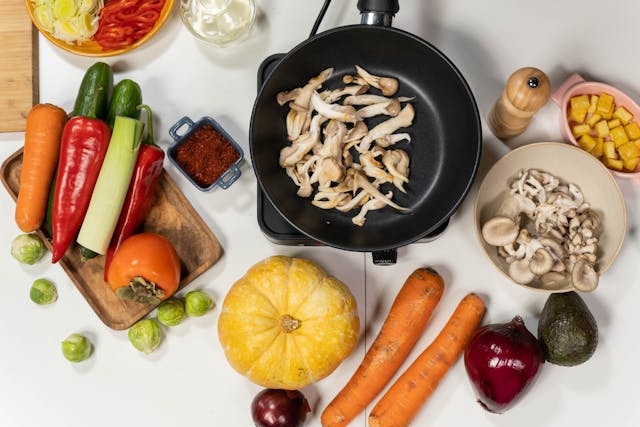Carbohydrates are essential for a healthy life and well-being. The main role of dietary carbohydrates is to provide energy for the body. The most important functions of carbohydrates. How to get the right carbohydrates from food?
Any excess carbohydrates not used for immediate energy production can be stored as glycogen inside the muscles and liver. Because the liver is able to release glucose into the bloodstream, it helps regulate blood glucose levels and insulin metabolism, which helps to avoid or cope with diseases such as diabetes and metabolic syndrome.
Carbohydrates perform the most important functions in the body: they serve as a source of energy, they participate in the creation of reserve reserves of various substances,
participate in the synthesis of interchangeable amino acids, serve as a material for cell growth,, nourish and activate brain cells, are part of many hormones, determine the blood group. Carbohydrates can be simple and complex, fast and slow.
(1)- How many carbohydrates should I eat?
“There is no one-size-fits-all amount of carbohydrates that people should eat. This amount can vary, depending on factors such as your age, sex, health, and whether or not you are trying to lose or gain weight. On average, people should get 45 to 65% of their calories from carbohydrates every day. On the Nutrition Facts labels, the Daily Value for total carbohydrates is 275 g per day. This is based on a 2,000-calorie daily diet. Your Daily Value may be higher or lower depending on your calorie needs and health.”
Simple and complex carbohydrates. The most important functions of carbohydrates. How to get the right carbohydrates from food?
Simple (or fast) carbohydrates include monosaccharides and disaccharides.
Monosaccharides — glucose and fructose — are absorbed instantly. While glucose and fructose are found in many food sources.
Disaccharides — sucrose, lactose and maltose — are also absorbed fairly quickly.
These two types of carbohydrates increase blood sugar levels in a short time. Complex carbohydrates include polysaccharides — cellulose, fiber, starch. These carbohydrates are broken down slowly. The body gradually receives the necessary energy, manages to spend it. And if it really consumes, it does not put it in fat. These carbohydrates supply the body with glycogen, the main reserve of glucose.
The effects of glucose and fructose on the body differ from each other.
Glucose, grape sugar, can be compared to jet fuel. It provides almost instant support for physical, emotional and mental stress. It quickly goes “into action” and if it remains, it turns into glycogen.
Fructose in optimal amounts gives the same effect. However, its excess is transformed into fat. This leads to overweight and the formation of visceral fat. And also — to the deterioration of the cardiovascular system, insulin resistance and diabetes mellitus.
Fruits and berries

Fruits and berries with the maximum amount of fructose: grapes, persimmons, bananas, apples and pears. It is better to eat these fruits in small quantities (about 7.0oz) in the morning. Especially if there is no active physical and psycho-emotional stress, which are very energy-consuming.
Fruits and berries with a predominance of glucose: plums, oranges, tangerines, peaches, grapefruits, berries. You can eat more of them –10.58oz- 14.20oz.
Natural sugars are found in fruits not in their pure form, but together with fiber, vitamins and trace elements and antioxidants. Therefore, when you eat whole fruit instead of drinking freshly squeezed juice, monosaccharides do not enter the bloodstream instantly. This means that there will be no sharp spike in blood sugar and insulin release.
Sugar, gingerbread, cookies, sweets, cakes contain a lot of pure glucose and fructose. They are quickly absorbed. It is better to exclude them or pamper yourself occasionally. But I suggest not to drive yourself into the strict limits of prohibitions. You should get pleasure from eating! Just read the composition and give preference to natural products. Please include more vegetables and salads in your daily diet. Try to make the ratio of vegetables and fruits 4:1 (by weight) It’s pretty easy, you just have to think about it.

Disaccharides. The most important functions of carbohydrates. How to get the right carbohydrates from food?
Like monosaccharides, disaccharides also belong to the category of simple sugars. However, disaccharides consist of three important molecules from a nutritional point of view: sucrose, lactose and maltose.
Sucrose consists of one glucose molecule combined with one fructose molecule. Examples include cane sugar, brown sugar, and date sugar. Sucrose is present as the main sugar in most fruits.
Lactose consists of one glucose molecule combined with one galactose molecule. It is found only in dairy products.
Maltose consists of two glucose molecules. Examples include corn syrup, brown rice syrup, and molasses.
Sucrose is cane or beet sugar. It breaks down into glucose and fructose, and is absorbed by 20%. The remaining 80% leave the body. Foods with a high sucrose content are less likely to lead to the development of diabetes mellitus than foods with a high content of pure glucose and fructose. Sucrose provides us with energy, protects the liver from toxic substances and activates the activity of the nervous system and muscles.
Fruits with a high sucrose content: mangoes, peaches, plums, oranges and tangerines. It is also found in nuts, legumes and vegetables. In all natural products, sucrose is contained in combination with other substances, which slows down its breakdown.

Sucrose, glucose and fructose deficiency lead to apathy, irritability, muscle weakness, lack of energy and even depression.
Lactose is a milk sugar that, when broken down, forms glucose and galactose. Galactose is formed in the intestine from lactose as a result of hydrolysis. It participates in the production of antibodies, improves the health of the cardiovascular and nervous systems, and has a positive effect on the balance of intestinal microflora. Lactose improves the absorption of B vitamins, vitamin C and calcium, activates the reproduction of bifidobacteria and lactobacilli, and preserves protein reserves.
The source of lactose is dairy products, which contain it in its natural form. Lactose is artificially introduced into ready-made sauces, chips, dry soups, bacon, sausages, sausages, confectionery, ice cream. Lactose is uncoupled by the enzyme lactase, which decreases with age. Therefore, dairy food, especially from cow’s milk, often causes discomfort even in healthy people.
Maltose is a malt sugar that is broken down into two glucose molecules. The body can independently synthesize maltose from starch and glycogen.
Maltose is a universal source of energy for cells. However, if you are intolerant of maltose or its excess in the diet, it can be harmful. Blood glucose levels increase and carbohydrate metabolism is disrupted. This leads to obesity, increased cholesterol, the development of heart disease and early atherosclerosis, the formation of prediabetes, hypertension, decreased immunity, increased fatigue, headaches.
Sources of maltose: kvass, beer, whiskey, bread, loaves, honey, pasta, soy sauce. There is a lot of maltose in sweet potatoes.

Oligosaccharides. The most important functions of carbohydrates. How to get the right carbohydrates from food?
This small and less frequently discussed group of polymer saccharides belongs to the category of complex carbohydrates, but usually contains only 3 to 10 units of sugar. These partially digestible polymers are found in legumes (e.g. peas, lentils or beans) and plant sources; they contain glucose, fructose and/or galactose.
Examples: Jerusalem artichoke, leek, onion and asparagus. Soybeans,
chicory root, sugar beet, leek, asparagus and banana.
Polysaccharides. The most important functions of carbohydrates. How to get the right carbohydrates from food?
Polysaccharides are also complex carbohydrates and include starches, fibers, and glycogen. Each of them contains long-chain glucose structures consisting of more than 10 units, but their size can reach several thousand units (for example, a glycogen molecule).
Starch is a slow carbohydrate. It is synthesized by green plants to conserve energy, which is consumed as needed. Under the influence of gastric juice, starch is converted into glucose starch sources: potatoes, rice, millet, buckwheat, corn, wheat, beans, peas, pasta, jelly.
Starch slows down protein absorption, so it is better to separate foods containing starch and protein products. I recommend eating starch-containing foods with vegetables more often. If you lead a sedentary lifestyle or have confirmed liver disease, it is better to reduce the amount of starch-containing foods in your diet.
Polysaccharide chains are arranged as straight-chain structures called amylose, branched-chain structures called amylopectin, and as a block structure called fiber.
Amylose is an easily digestible form of starch with a straight chain containing
glucose molecules.
Amylopectin. An easily digestible form of branched chain starch containing
glucose molecules.
Fiber. The most important functions of carbohydrates. How to get the right carbohydrates from food?
Fiber makes up most of the indigestible part of plant foods, it is not a separate compound. This is a group of compounds that have similar characteristics and are usually classified as soluble or insoluble.
Examples of soluble fiber are pectins, gums, and mucous substances that form inside a plant cell. They are called soluble because they either dissolve or swell when placed in water, and most of them can be digested by bacteria living in the large intestine. Therefore, they are also sometimes called fermentable.
Soluble fiber is the intracellular contents of plants. It dissolves in water and, under the influence of intestinal microflora, ferments and turns into a jelly-like mass. Soluble fiber slows down the breakdown of carbohydrates, lowers blood glucose and cholesterol levels, and normalizes the microbiome. Soluble fiber is classified as a prebiotic. However, with dysbiosis and candidiasis, fiber serves as a nutrient medium for unfriendly flora. Therefore, you should not eat a large amount of fiber until the intestinal microflora is restored. Soluble fiber includes: inulin, pectin, gums, mucus, alginates.
Soluble fiber includes: inulin, pectin, gums, mucus, alginates.
Sources of soluble fiber: root vegetables and tubers, chicory, jerusalem artichoke, vegetables, fruits, legumes, oats, barley, pears, apples, beets, zucchini, pumpkin, carrots, oranges, flax and chia seeds, red, brown and green algae.

Insoluble fiber is the shell of plant cells, while moving through the gastrointestinal tract it remains unchanged. Insoluble fiber includes: cellulose and hemicellulose, chitin, lignin.
Sources of insoluble fiber: vegetables, fruits, nuts, seeds, cereals, legumes, mushrooms, especially dried white ones. All fiber is needed by our body. It accelerates the passage of food through the gastrointestinal tract, improves peristalsis and fights constipation. It also helps to eliminate toxins and toxins, reduces allergic reactions, prevents obesity, and maintains an optimal PH level.
(2) – “Carbohydrates are one of the three macronutrients in the human diet, along with protein and fat.”
(1) – (US) National Library of Medicine; Carbohydrates. https://medlineplus.gov/carbohydrates.html
(2) – (US) National Library of Medicine; Physiology, Carbohydrates; Julie E. Holesh; Sanah Aslam; Andrew Martin; Last Update: May 12, 2023.
https://www.ncbi.nlm.nih.gov/books/NBK459280/



